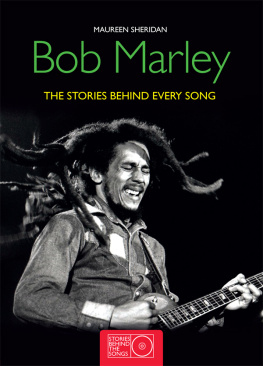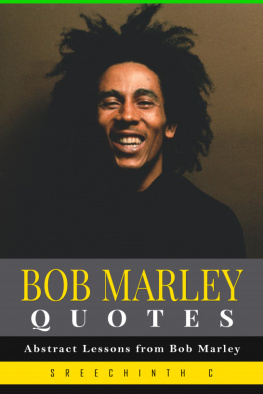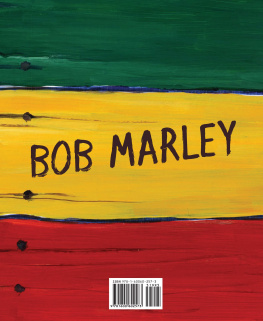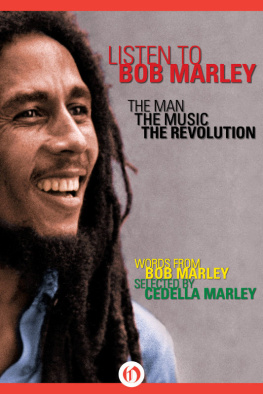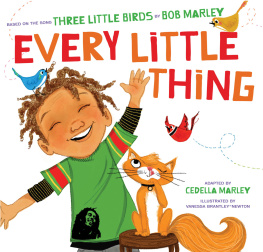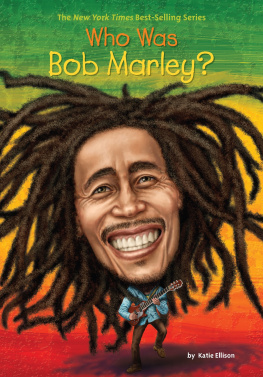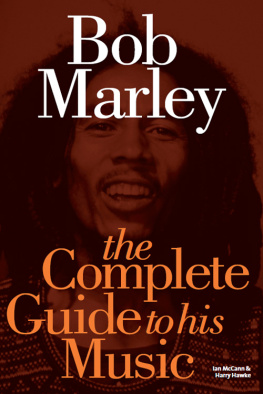THIS IS A CARLTON BOOK
This edition published by Carlton Books Limited 2011
Text and design copyright Carlton Books Limited 1998, 2011
This book is sold subject to the condition that it shall not, by way of trade or otherwise, be lent, resold, hired out or otherwise circulated without the publishers prior written consent in any form of cover or binding other than that in which it is published and without a similar condition including this condition, being imposed upon the subsequent purchaser.
All rights reserved.
eISBN 978-1-78011-212-1

CONTENTS

BEGINNINGS
At first glance, Nine Miles, in St Ann, Jamaica, the birthplace of Bob Marley, is nothing out of the ordinary. But then look again, and listen closely for the natural mystic that really does run through the air, and this typical Jamaican village of brightly-painted, one-room board houses, perched on a hillside nine miles from nowhere, starts to feel different.
In 1944, Jamaica was still a colony, and Captain Norval Marley, a middle-aged white Jamaican of the British West India Regiment, was stationed in the parish of St Ann. Then, as now, a white man in rural Jamaica was a rarity and to young Cedella Malcolm, Captain (as she called him) cut a fine figure as he rode his horse around the area.
Captain Marley was well-liked by the villagers of Nine Miles, and had been a long-time friend of Cedellas father, Omeriah Malcolm. By Miss Marleys account, the short, slim, white soldier had had his eye on her for some time before seducing her when she was only 16 years old, in the small house that the Captain who Cedella remembers as very handsome, very loving, very sweet had been renting from her grandmother, YaYa.
Robert Nesta Marley was conceived one seemingly ordinary night in early May. He told me he loved me and I believed he did, says Cedella of the Captain, who wed her in a short service held on her grandmothers veranda eight months before her babys expected birth.
The day after the wedding, the Captain departed for Kingston, coming back to Nine Miles only a couple of times to see the straight-nosed mulatto baby boy who had been born on February 6, 1945, in the little house up on the hill that he had purchased for his young bride.
After a rather idyllic first few years in the never-ending childrens playing-field that is rural Jamaica, Marleys father came back into his life to take him, as is the norm for many Jamaicans, to boarding school in Kingston. A photograph taken shortly after he left home, shows the young, brown Marley boy with his hair in a very British side-parting, a visual reminder of the two very different cultures from which he had been created.
For several months after Nesta had left home, Cedella didnt hear a thing from either husband or son. Then, she recounts, an acquaintance saw the six-year-old playing on a Kingston street. Mrs Marleys trip to town to find Nesta resulted in her taking him back to the country, discovering him as she did, not at boarding school, but on the streets of downtown Kingston where he had been living with an old lady named Miss Grey. A year or so later, the young Marley would move back to town with his mother, a move very difficult for him at the time, but one which would prove critical to his destiny.
As the john-crows fly, Nine Miles and Trench Town are a mere 80 miles apart, but worlds apart in culture and living conditions. Nesta had a hard time fitting in country come a town say Jamaicans to sum up the shock. But, as childhood gave way to adolescence, Nesta began to grow comfortable with the ghetto (too comfortable, his mother would later lament), where his friendship with two other country bwoys was about to give him one hell of a future.

KINGSTON 13
Around the time of the late Fifties and early Sixties, Jamaican music was just beginning to bubble. Opportunities to cut a tune for the ruling producers of the day abounded. Nesta Marley, and his longtime friend Neville Livingston (who later would become Bunny Wailer), along with other budding talents of the area like Desmond Dekker, teamed up together (while Marleys mother, Cedella, teamed up with Taddy, Livingstons father) and started to get gigs in local bars with the intention of getting tight enough for the recording studio. But as Marleys dreams of a future in music grew stronger daily, his mother, in the way of many of her generation, was steering him towards a real job welding.
Mrs Bookers version of this short-lived apprenticeship has it ending with Bobs eye injury on the job. Marleys own version has the eye injury happening to Desmond Dekker (whod followed him to the welding yard). Either way, it was a fortuitous injury for both of them. As Marley told it: The days him (Dekker) have off him check out Beverleys (production company) and him do Honour Thy Father And Mother a big hit in Jamaica. After that him say, come man.
From the beginning, Chinese Jamaicans have had a strong hand in the islands pop music industry, and restauranteur, Leslie Kong, was one of the first Chineys to set up shop naming his label Beverleys after the restaurant he operated, with his brother, in downtown Kingston (and which also served as a legal front for a Chinese numbers game). Kong was enticed into music production by a young and eager James Chambers (soon rechristened by Kong as Jimmy Cliff). Cliff, in turn, told his friends, including Desmond Dekker, about Kong. Marley, encouraged by Dekker, soon also found his way to Federal Records (Kongs production base) which was a mere couple of miles from Trench Town, and which Rita Marley would buy in 1985 and turn into Tuff Gong.
Neither Marley nor Kong ever saw their relationship as anything but business. In fact, when Kong died at 38, it was widely believed that his death was due not to a heart attack as officially reported, but to an obeah (voodoo) curse put on him by Bob for releasing an album The Best Of The Wailers without permission. As intriguing as this obeah story is, Bunny Wailer dismisses it angrily, as he dismisses other obeah rumours, as an outright lie. What remains unchallenged, however, is the fact that Bob Marley didnt like Leslie Kong.
Unlike later producers of Marleys work like Coxsone Dodd and Lee Scratch Perry, Leslie Kong is not known for having a serious ear for music, nor did he have any technical capability in the studio. But even when relegated to the role of financial backer, Leslie Kong certainly had a feel for which artists to back. And Randall Grass, founder of Shanachie Records, has written of Kongs ear for quality, noting that, contrary to popular opinion, he did have a signature sound.
Allowing that Kong lacked Perrys depth and Dodds innovation, Grass credits Kong who would one day oversee the Paul Simon Mother And Child Reunion sessions at Dynamic Studios with stripping the music down to gimmick-free formulaic essentials. And no one can deny Kongs instinct for business. He was the first investor in Chris Blackwells Island Records, a risky but ultimately very profitable decision that, sadly, he never lived to enjoy.
Judge Not, and the other song that was recorded at that first session, Do You Still Love Me?, were released both in Jamaica and Europe (the latter release, significantly, by Chris Blackwell whose fate would be so intertwined with Marleys) under the artist name, Bob Morely the way many Jamaicans pronounce Marley. Kong also tried to get Marley to change his name to Bobby Martell ( la Bobby Rydell), but although at least one record would go out under that pseudonym, it didnt stick.
Next page
